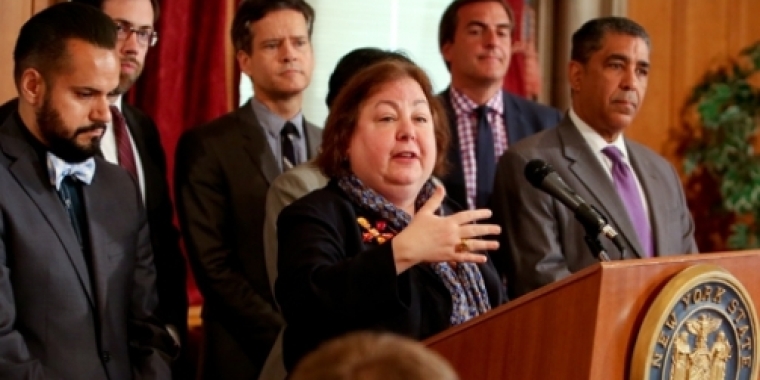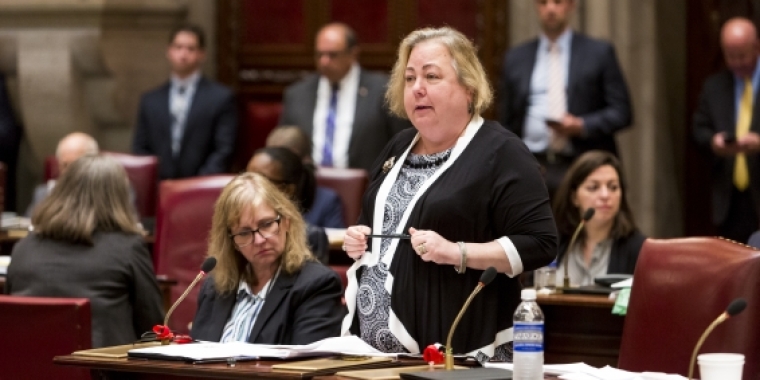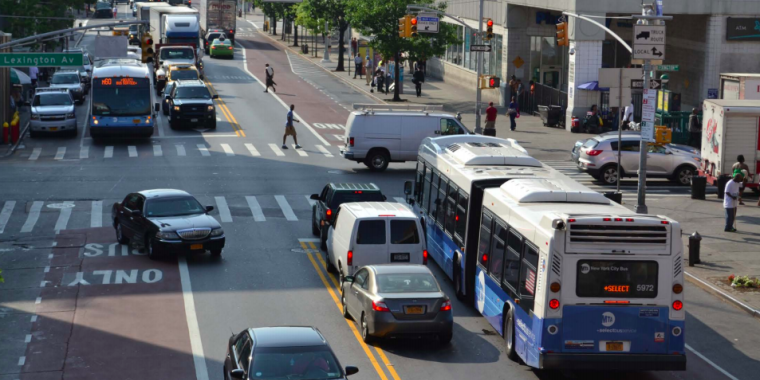
Testimony at the Department of City Planning’s SEIS Scoping Session for the First Avenue Properties Rezoning on March 28, 2006
Liz Krueger
July 15, 2010
My name is Liz Krueger and I represent the 26th State Senate District, which includes the proposed rezoning area as well as the Upper East Side, East Midtown and Midtown neighborhoods of Manhattan. I appreciate this opportunity to comment on the Department of City Planning’s proposed rezoning of the First Avenue Properties, commonly known as the former Con Ed sites. I regret that, because the State Senate is in session in Albany, I am unable to appear today in person.
I look forward to the City Planning Commission engaging in a comprehensive community planning process that is guided by sound planning principles, and thoroughly studying the impacts of such a large-scale development on the surrounding community and City services. The residents of the neighborhoods surrounding the proposed rezoning area are faced with a potential development that is unprecedented in its magnitude and range of possible impacts on the community. It is essential that you take the legitimate concerns of my constituents into account when evaluating the rezoning of this land.
I am lucky and proud to represent the incredibly talented and dedicated members of Manhattan Community Board 6, in whose district this rezoning is being proposed. Community Board 6’s land-use committee has a professional planner and architect among its very experienced and knowledgeable members. More importantly, the members of this committee and the full board have a unique understanding of this neighborhood, and their participation should be embraced. Community Board 6 has worked for more than 8 years studying, analyzing and discussing the nature of development that should take place on the former Con Ed sites, recently laying out its own visions for the area in 197a and 197c plans submitted to the Department of City Planning. The Community Board’s vision represents a plan that would alleviate many of the impacts of the developer’s proposed action that were identified in the Final Generic Environmental Impact Statement done by the Public Service Commission, and provides numerous benefits to the community. I strongly urge City Planning to consider and comprehensively study the 197c plan submitted by Community Board 6.
Over the past fifty years, a number of forces have significantly altered the relationship of the City to its shoreline. For most of New York’s history, the waterfront was the locus for industrial and commercial development, and although functional, the Con Edison plant is a relic of this era. In the post-industrial city, we have an opportunity to reclaim the waterfront for purposes that address the civic and social needs of our community. The sites being discussed offer the rare chance to create an exceptional project that is connected to both the City and the river—that addresses the needs for affordable housing, open space, and waterfront access.
Unfortunately, with these massive opportunities there is the potential to make colossal mistakes. Overdevelopment, or inappropriate development, runs the risk of negatively impacting traffic, open space, and school capacity, while casting shadows and aesthetically disrupting our visual resources.
In order to take full advantage of the opportunities we have before us today, and prevent unnecessary errors, the Department of City Planning must expand and amend the scope of the Supplemental Environmental Impact Statement (SEIS) for the rezoning. In collaboration with seven other East Side and Borough-wide elected officials, I will be submitting a joint in-depth technical analysis of the proposed scope for the SEIS and the revisions that we believe must be made. Our joint analysis outlines a considerable number of serious concerns we all share about the developer’s proposal and the draft scope of the SEIS—ranging from its failure to provide true accessible open space and access to the waterfront to its potential to overburden City services and infrastructure. I am extremely concerned about all of the issues outlined in our joint submission, and am pleased to be working so collaboratively with my fellow City, State and Federal elected officials. However, because of limited time, the elected officials have decided to divide the issues we are all concerned about amongst ourselves. I will be focusing on the tremendous need for the production of a significant amount of mandatory permanent affordable housing in any development which takes place on this property.
Inappropriate development that overwhelms the scale and services of surrounding neighborhoods is not the only threat to many City neighborhoods. Ever escalating housing costs and gentrification have eroded, and threatens to erode, the unique character and diversity of communities all across the City. The City’s skyrocketing housing market, along with the loss of hundreds of thousands of previously affordable regulated units in recent years, has created an acute affordable housing crisis for low- and middle-income New Yorkers.
According to the 2005 New York City Housing and Vacancy Survey, the vacancy rate for units available for rent is 3.09%, significantly lower than the 5% level which indicates an emergency condition under New York State law. More than 22% of renter households have incomes below the federal poverty level, and the inflation adjusted income of all households across the City decreased by 6.3% between 2001 and 2004. Seniors, the disabled, and others on fixed incomes have been particularly hard-hit by the explosion in housing costs. More than 175,000 low-income New Yorkers are on multi-year waiting lists for public and senior housing, and new applications for Section 8 have been closed since 1994. These Citywide trends are reflected within the communities surrounding the proposed rezoning area as well. According to the 2000 census, 11,227 people living in Community Board 6 live in poverty, nearly 35% of residents of this area face rent hardship burdens as defined by the federal government, and more than 10,000 additional affordable units are needed within the boundaries of the Community Board simply to meet the needs of existing residents in poverty and/or paying more than half their incomes in rent.
This crisis threatens to transform New York into a city of economically and racially segregated neighborhoods, with no room for the middle class. The future of our city is placed at risk as residents are forced out of their homes and communities. The low and moderate income workers upon whom our economy depends are finding it more and more difficult to get by, with housing either unavailable or so expensive that it impoverishes them. This is why City Planning must incorporate a significant amount of permanently affordable units, through the use of inclusionary zoning and other creative tools, in every large-scale rezoning it contemplates.
As our state and federal governments have unfortunately continued to ignore the affordable housing crisis facing our City and nation in recent years, New York City’s government has substantially expanded its commitment to housing, both through additional capital resources and a search for new tools and strategies to effectively use market forces to create affordable units. Mayor Bloomberg recently announced a $7.5 billion plan to build and preserve 165,000 affordable housing units by 2013, the largest municipal affordable housing plan in the nation’s history. A key component of the Mayor’s plan is the increased use of inclusionary zoning.
Inclusionary zoning is a policy tool used increasingly by cities, counties and states across the county to create affordable housing; many more municipalities are considering creating or strengthening their existing programs. It establishes either requirements or incentives for developers to include affordable housing in new developments, often by allowing developers greater density in exchange for providing a certain amount of affordable housing. Whenever an area is being rezoned, whether from manufacturing to residential or commercial or allowing increased density, landowners receive a substantial windfall as a result of a public action. Studies conducted by the Pratt Center for Community Development, Policy Link, the Urban Land Institute and others have shown that in some cases land values will grow by more than 500% as result of rezonings. Inclusionary zoning is a way to capture a portion of the new market value created by a public action for a public good. Inclusionary zoning programs have led to the creation of hundreds of thousands of affordable units across the country, while also enhancing mixed-income communities and improving economies.
Although New York City has had a small inclusionary zoning program for more than two decades, it has been very limited in its scope, producing approximately 600 units through 2004. I was extremely pleased to see City Planning, the Department of Housing Preservation and Development, and the City Council work closely together to generate new and innovative inclusionary housing programs during the recent rezonings of Hudson Yards and Williamburg-Greenpoint. These plans created zoning texts that grant developers voluntary density bonuses in exchange for making up to 28% of all units at Hudson Yards, and 33% of all units in Williamsburg-Greenpoint, permanently affordable for households of various income levels.
At a minimum, City Planning should follow the precedents set in these recent rezonings, and include the full study of the Hudson Yards and Williamsburg-Greenpoint models in the SEIS. However, in addition, I call upon City Planning to comprehensively study a zoning plan which mandates that any and all residential development on the First Avenue Properties include a required number of units that will be permanently affordable for low and middle-income households. Numerous nationwide studies have shown that while voluntary inclusionary zoning is useful, mandatory programs are exponentially more successful at ultimately creating significant numbers of affordable units. As a result, most municipalities establishing new inclusionary programs, and many cities and counties that once had voluntary programs, such as Cambridge, Massachusetts and Boulder, Colorado, are making their programs mandatory. A mandated minimum number of affordable units is especially important in New York City’s current real estate market in which most developers are choosing to build exclusively condominiums, in which voluntary zoning tools cannot usually be utilized.
The owner of the First Avenue Properties, East River Realty, has asked the City of New York to change the zoning in the area from manufacturing to commercial and to dramatically upzone those parcels already zoned commercial. It is evident that, regardless of the specifics of the final rezoning approved, through its actions the City will be substantially increasing the value of the East River Realty’s land. The Draft Scope of Analyses for the SEIS states that an “analysis which considers the provision of moderate income units” will be done. This is grossly insufficient given the affordable housing crisis facing out community and our City and the private windfall the developer stands to gain through public action.
City Planning should broaden the scope of the SEIS to include a full study of these inclusionary zoning issues, as well as all of the other concerns and proposals of Community Board 6, affected neighborhood organizations and advocacy groups, and my fellow elected officials. Otherwise, these proposals will be shut out of consideration as the plan goes through the ULURP process. I look forward to working with City Planning, the Community Board, community and civic organizations, and other elected officials to develop a rezoning that reflects the area’s character and plans wisely for the future of our City.
Share this Article or Press Release
Newsroom
Go to Newsroom
Senator Krueger's Community Bulletin - June 2018
June 8, 2018

